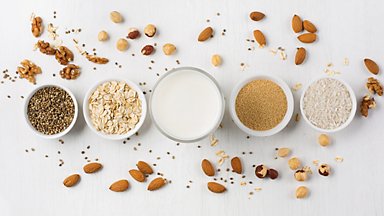Oat beverages are booming.
Here’s why
Suddenly, oat-based beverages are everywhere — maybe even in your own cup of coffee this morning. Beverage producers of all kinds — from dairies to soft drinks manufacturers to start-ups — have taken note and are scrambling to get in on the act. But even after several years of exponential growth in key markets, industry experts suggest the popularity of oat drinks is just getting started. So how did we get here, and where are we headed?

The process of creating a beverage from milled oats was developed in the mid-1990s at Lund University in Sweden. It was the result of a study on lactose intolerance by food scientist Rickard Öste, who went on to found Oatly.
Fast forward to present day, and what began as an outlier in the dairy alternative space has become a bona fide juggernaut. Globally the market is projected to reach USD 6.8 billion by 2026, with a combined annual growth rate of 13.4%.i
The US and Vietnam have emerged among the top markets for oat-based beverages, as has Europe, with consumption of oat-based beverages increasing by 50% between 2019 and 2020. Sales the UK were up 40%, and in Germany by 102%. In the birthplace of what is commonly called oat milk, Sweden, sales rocketed by a massive 186%.ii
The broader plant-based beverage market — which includes soy, coconut, almond and rice-based products — continues to grow strongly, but it can’t keep up with oats. Oat beverages surged past soy in 2020 to become the most popular plant-based beverage in Europe, accounting for 36% of sales, against soy’s 30%.
Sustainability and wellness driving success
Riccardo Trovato, strategy and category leader for plant-based products at Tetra Pak, says the oat beverage boom is unprecedented. He names three main factors driving the surge, with sustainability at the top of the list.
Referring to the Tetra Pak Trendipedia study of global consumer trends, Trovato says that consumers want to feel greater connection with their surroundings and view themselves as environmental and social guardians. And they increasingly expect the same attitudes from the brands behind the products they buy. “Compared to other plants, oats have a very good sustainability profile and this is why more companies and consumers are interested in it.”
The second factor behind the oat-based boom is the fact that today’s consumers are increasingly choosing products that support their health and wellness goals. “Especially during the pandemic, consumers are looking for products that make them feel better,” Trovato says. “So we’re seeing a reduction in the consumption of sugary products, and an increase in the consumption of plant-based products, which are seen as being more healthy.”
Oat drinks are naturally high in fibre and fortified with nutrients such as calcium, potassium iodide, and vitamins D2, riboflavin and B12. Plant-based alternatives to dairy are especially important to lactose-intolerant consumers, who are increasingly choosing oat drinks over options made from almonds or soy.
It’s a matter of taste
Trovato says this shift towards oats comes down to another very important factor: taste. You can have the healthiest, most sustainable beverage — but if it doesn’t taste good, people won’t drink it. Oat drinks have the advantage of being naturally sweeter and creamier than other non-dairy alternatives.
“This is where oats are very strong,” Trovato says. “For many consumers, oat beverages taste better than most of the other plant-based products out there. Taste is the number-one factor for attracting new consumers.”
No company has attracted more new consumers to oat-based beverages than Oatly, which expanded to the United States in 2016. The company has used a quirky marketing campaign to build a fan base and attract high-profile investors, such as Oprah Winfrey and former Starbucks chief Howard Schulz.
The future of oat beverages
So having come from nowhere to become a staple product on the supermarket shelves and coffee menus, what lies ahead for oat beverages? “There is still room for growth to continue, but of course we won’t see double-digits forever,” Trovato says. “After a while I expect we’ll see other products with new ingredients come in and slow down that growth.”
Some of those new products are likely to come from established dairy providers, which seem to be taking an “if you can’t beat ‘em, join ‘em” approach to oat drinks in hopes of clawing back market share from the plant-based upstarts.
Trovato says larger companies may be better positioned to capitalize on the oat-based beverage trend because of the challenges that come with new ingredients.
“Processing an oat is totally different from processing milk or processing a soybean,” he says. “You need to adapt your equipment and your knowledge to develop and market a new product.”
i Global Oat Milk Market By Source, By Packaging, By Product, By Application, By Region, Industry Analysis and Forecast, 2020 – 2026, February 2021
ii IRI/Nielsen/Kantar Q4 2020



